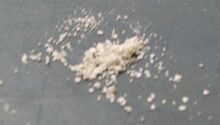Chemistry:Zinc borate

| |
| Identifiers | |
|---|---|
| |
PubChem CID
|
|
| UNII | |
Except where otherwise noted, data are given for materials in their standard state (at 25 °C [77 °F], 100 kPa). | |
| Infobox references | |
Zinc borate is an inorganic compound, a borate of zinc. It is a white crystalline or amorphous powder insoluble in water. Its toxicity is low. Its melting point is 980 °C.
Variants
Several variants of zinc borate exist, differing by the zinc/boron ratio and the water content:[1]
- Zinc borate Firebrake ZB (2ZnO·3 B2O3·3.5H2O), CAS number 138265-88-0
- Zinc borate Firebrake 500 (2ZnO·3 B2O3), CAS number 12767-90-7
- Zinc borate Firebrake 415 (4ZnO·B2O3·H2O), CAS number 149749-62-2
- ZB-467 (4ZnO·6B2O3·7H2O), CAS number 1332-07-6
- ZB-223 (2ZnO·2B2O3·3H2O), CAS number 1332-07-6
The hydrated variants lose water between 290–415 °C.
Uses
Zinc borate is primarily used as a flame retardant in plastics and cellulose fibers, paper, rubbers and textiles. It is also used in paints, adhesives, and pigments. As a flame retardant, it can replace antimony(III) oxide as a synergist in both halogen-based and halogen-free systems.[2] It is an anti-dripping and char-promoting agent, and suppresses the afterglow. In electrical insulator plastics it suppresses arcing and tracking.
In halogen-containing systems, zinc borate is used together with antimony trioxide and alumina trihydrate. It catalyzes formation of char and creates a protective layer of glass. Zinc catalyzes the release of halogens by forming zinc halides and zinc oxyhalides.
In halogen-free system, zinc borate can be used together with alumina trihydrate, magnesium hydroxide, red phosphorus, or ammonium polyphosphate. During burning the plastics, a porous borate ceramics is formed that protects the underlying layers. In presence of silica, borosilicate glass can be formed at plastic burning temperatures.[3]
Zinc borate is used in polyvinyl chloride, polyolefins, polyamides, epoxy resins, polyesters, thermoplastic elastomers, rubbers, etc. It is also used in some intumescent systems.[4]
Zinc borate has synergistic effect with zinc phosphate or barium borate as a corrosion inhibitor pigment.
Zinc borate acts as a broad-spectrum fungicide in plastics and wood products.[5]
Zinc borate can be used as a flux in some ceramics. In electrical insulators it improves the ceramics properties.
Nanopowder zinc borate can be used for the applications above, and also for improving the frictional properties of lubricating oils.[6]
References
- ↑ "Flame Retardants Fact Sheet, Zinc borate". Cefic. January 2006. http://www.cefic-efra.com/Objects/2/Files/ZincBorateFactsheet.pdf.
- ↑ "Zinc Borate (Boric Acid, Zinc Salt)". Chemical Land21. http://chemicalland21.com/industrialchem/inorganic/ZINC%20BORATE.htm.
- ↑ "Firebrake zinc borates for plastics". Luzenac Group. http://www.luzenac.com/plastics_zinc_borate.htm.
- ↑ Bellingham, F. (25 November 1992). "Zinc borate in intumescent paints". European Polymers Paint Colour Journal. http://www.accessmylibrary.com/article-1G1-13603942/zinc-borate-intumescent-paints.html. Retrieved 6 February 2010.
- ↑ "zinc borate (Firebreak ZB) EPA Pesticide Fact Sheet 10/91". Pesticide Management Education Program. 1 October 1991. http://pmep.cce.cornell.edu/profiles/fung-nemat/tcmtb-ziram/zinc-borate/fung-prof-zinc-borate.html.
- ↑ "Nano-zinc borate". Shandong Xinruida Chemical Co., Ltd. http://www.sdxinruida.com/cgi/search-en.cgi?f=product_en+product_en_1_+company_en_1_&id=594059&t=product_en_1_.
External links
- Zinc borate in the Pesticide Properties DataBase (PPDB)
 |

